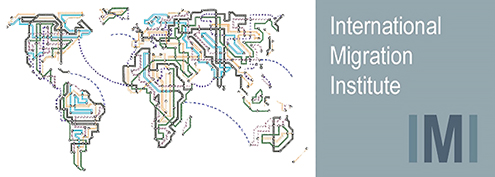On 10 November Hein de Haas, now Professor of Sociology at the University of Amsterdam, presented 'Behind the headlines: investigating the drivers and impacts of global migration' at the Oxford Martin School. Addressing a packed lecture theatre, Hein began by outlining his fundamental point that migration needs to be reconceptualised as a normal process and part of wider processes of change including urbanisation and industrialisation. Neither a bad nor a good process, but an inevitable one, Hein compared being either in favour or against migration to being in favour or against agriculture, or trade.
Hein introduced the DEMIG project, a major five-year research project conducted at IMI and funded by the European Research Council, data from which Hein drew upon throughout his talk. Briefly presenting the databases gathered on bilateral migration flows, total migration flows, policy changes over time, and visa policy changes, Hein highlighted several popularly held migration myths, both right- and left-wing.
The first myth is that we live in a time of unprecedented mass migration, and in particular that the rich countries of the world are under increasing pressure from migration. Using data from the UN Population Division and the Global Bilateral Migration Database, but crucially expressing it as a percentage of the world population, Hein demonstrated that, rather than migration rapidly accelerating, the levels have remained remarkably constant over the last half-century - around 3% of the population are international migrants. It is therefore not possible to create a narrative of global migration being on the rise. Looking at data on the make up of migrant populations, Hein further concluded that the narrative of refugees comprising the majority of the migrant population is fundamentally flawed. Addressing the European question, Hein emphasised that although the number of refugees in Europe has steeply increased, it still has not reached previous levels, e.g. during the Balkans conflict, and is not an unprecedented phenomenon. We can therefore talk neither of an exodus, nor of an invasion. Europe has become a global migration magnet in recent years, countering its past as a sending country, said Hein, and in doing so has reversed the trend from outbound to inbound migration.
The second myth addressed was that migration policies have become more restrictive. Drawing on DEMIG research Hein demonstrated that in fact they have become less so. He unpacked different types of policies, particularly those targeting the high-skilled, the wealthy, and students, for whom policies have become progressively more relaxed over time. In most migrant categories, policies have become less restrictive; only those policies governing border and land controls have become more restrictive. At the same time as creating more entry channels for particular groups, visa policies have been blocking entry of people from poorer countries, including those from Africa. The picture is ambiguous, showing migration policy is not primarily about numbers but about selection.
He went on to debunk the third myth, that immigration restrticions reduce immigration, showing the many unintended consequences - 'substitution effects' of certain migration policies.
The fourth myth Hein addressed was that development in poorer countries will reduce emigration. Data tell a more nuanced picture, using the Human Development Index categorisation of develoment to demonstrate that it's not the poorest countries that generate the most migration, but those in the middle grouping, and that development is therefore likely to generate more and not less migration.
Hein then turned to the fifth migration myth, that migration leads to 'brain drain', and the recurring argument that it is a barrier to poorer countries' development. Drawing on research from Michael Clemens at the Center for Global Development, Hein underlined that it would be erroneous to suggest that migration is the main cause of development stagnation - this overestimates the influence of migration. The other side to this story is the resources provided by migrants, principally remittances sent back to origin countries.
The six myth, that migrants steal jobs and threaten the welfare state, was shown to be much more nuanced. Hein concluded from the literature that the economic impact of migration is actually quite small.
Hein turned to his last chosen myth, that migration can solve the ageing problem, emphasising that migration levels would have to be enormous in order to have this effect, particularly given that migrants very quickly adapt their fertility patterns to destination countries. Migration, therefore, is not a quick fix to the world's ageing population.
Concluding his talk, Hein emphasised that evidence forces us to revisit these seven migration myths. Migration, he concluded, is a normal process tied to individual freedom and intrinsic to wellbeing - having the option alone to migrate can give you satisfaction; many people do not exercise it. Drawing on the work of Jørgen Carling Hein said we in fact live in a world not of migration but of involuntary immobility.
